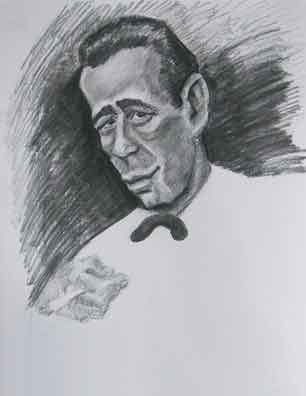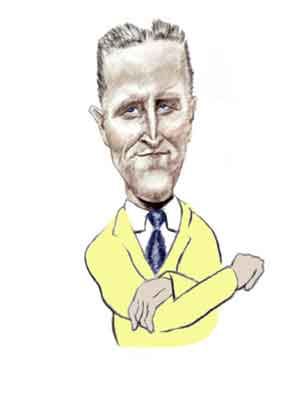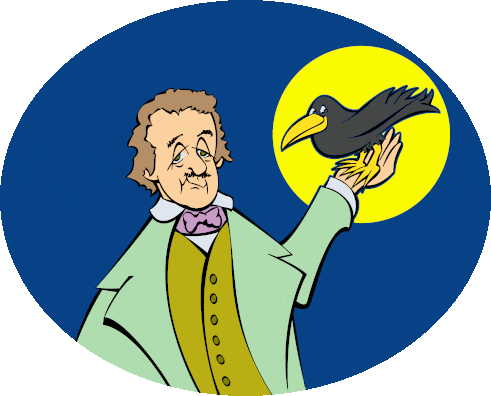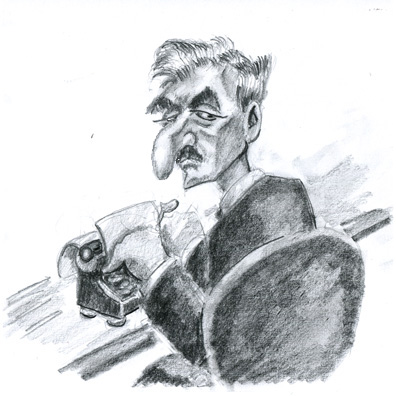Burt Lancaster
and
Ava Gardner
(Click on the image to zoom in and out)
Fans of the Golden Age of Hollywood know Burt Lancaster and Ava Gardner. Equally well known to the Golden Age aficionados is the once popular genre called the film noir (pronounced film NWAHR). Gumshoes. Cops. Crooks. Hard bitten dialog. Stories told in flashback.
But most of all films noirs were shot in black and white with particular emphasis on the interplay of light and shadows. So you had plenty of night scenes on dark rain swept streets. Neon lights shining in windows of cheap hotels. Smokey barrooms with long counters.
Of course today when movie fans see a black and white film and wonder what went wrong with the projector, many of the old noir films are being colorized. But this is anathema to the purists. It's film noir, for crying out loud, not film colorisé!

Bogey
Film Noir Hero
Like so many artistic genres, there is really no clear cut way to define film noir. In some cases debate rages. For instance, is Casablanca a film noir? Certainly much of the cinematography looks noir. And Bogey has the looks of the noir hero. But the story line and plot - which has no flashbacks - are not typical of the genre.
On the other hand, the 1946 film The Killers is a quintessential film noir. Basing the script on a 1927 short story written by Ernest Hemingway, the screenwriters had to find a way to stretch ten pages of print over an hour and forty minutes of action. One good way to do this was to write the first ten minutes of the film based on the story. Then spin the rest out of Hollywood cloth.

Ernest
The story - and the first minutes of the film - is pretty simple. Two hitmen named Max and Al walk into a diner in the Chicago suburb of Summit, Illinois, where they expect a boxer name Ole Andreson to come in for dinner. When it's evident "The Swede" isn't going to show, they tie up the manager George, the cook Sam, and the lone customer, a young man named Nick. They then leave. Before they left the two hitmen were surprisingly garrulous and told their prisoners they were going to bump Ole off when they find him.
Eventually, the three men free themselves and Nick goes out to warn Ole. He finds him laying in his bed fully clothed. Nick tells him about the two hit men and that they are looking for him.
But Ole seems completely indifferent to the news. There's nothing, he says, he can do. Nick then leaves and returns to the diner and tells George about Ole's surprising resignation to his fate. Nick then vows he'll leave the town and George says that's a good idea.
In the movie the first part ends with Nick leaving Ole - played by Burt - in his room. But then the two hitmen show up. They kick the door open and fire their guns, killing Ole who made no effort to resist.
The next hour and half is the story of the cops and an insurance investigator attempting to catch the hitmen and find out who sent them. The background of the story is told in flashback and by the time the movie's over, everyone knows what was going on. In deference to those who want to see the film, further discussion will be limited to saying that throughout the movie a curvaceous babe named Kitty Collins - played by Ava - is heavily involved with Ole.
In the print story, though, no one ever learns why the hitmen wanted to bump off Ole or why he didn't try to get away. It's not even clear if the killers actually found Ole or not.
In writing "The Killers" Ernest adhered to his theory that a story is strengthened in direct proportion to what is left out. He said that sometimes he could even lop off the first five hundred words of a story and that would improve it. A good story should be thought of in terms of an iceberg where only 15% can be seen and the rest is out of sight.
Ernest may have gotten the idea of improving a story by leaving a lot out from Scott Fitzgerald. When Ernest was writing his first novel, The Sun Also Rises, he had originally provided detailed introductions for all the characters. But Scott suggested the early paragraphs were unnecessary because everyone's background unfolded during the course of the story.

Scott
Outside of the movies Ava was a good friend of Ernest and played the leading lady in three Hemingway films. In addition to The Killers, she starred in The Snows of Kilimanjaro with Gregory Peck, and she played Brett Ashley in The Sun Also Rises with Tyrone Power as Jake Barnes. Ernest referred to Kilimanjaro as The Snows of Zanuck and had taken exception to where the ending had been altered to what the producers evidently considered only a minor change in the plot. The main character, Harry Street, lives instead of dying.
Ernest was also critical of the adaptation of the Sun Also Rises even after he had summoned the scriptwriter, Peter Viertel, for a rewrite after Ava showed him the initial script. Producer Daryl Zanuck expressed bewilderment about Ernest's dissatisfaction since the film kept with the novel's story line about as well as could be expected. Ernest's remark was that any movie with Errol Flynn had to be its own worst enemy.
In the movie The Killers Burt and Ava are the main characters. But the main character in the short story was a young man named Nick Adams who appeared in 16 other Hemingway stories that were published from 1924 to 1933. "Indian Camp" introduces the reader to Nick as a young boy and the series continues through his teen years to his young adulthood. The stories were modeled on Ernest's own early life in Illinois and Michigan, and his time during World War I as a Red Cross worker and ambulance driver in Italy. In the last story Nick is married with a son.
But in the movie we see Nick only in the first few minutes. The role, filled by character actor Phillip Brown, wasn't even credited. Nick was in mostly in medium and medium long shots, a directorial selection which may have been intended to disguise the fact that Phil was over forty at the time and Nick was supposed to be in his late teens or early twenties.
Perhaps it was because the first part of The Killers followed the story so closely that it was one Hemingway film that received Ernest's rare approval. He even owned a copy of the film. So when Ernest had visitors to his home in Cuba, the Finca Vigía, they would be treated first to a film of a boxing match where Ernest provided a commentary and the match was followed by a showing of The Killers. Inevitably Ernest would fall asleep after the first reel.1
Footnote
In the era of digital movies it's forgotten how cumbersome it was to make and show a movie of any length. The images were recorded on celluloid or acetate film and stored on reels. The film was threaded through a light projector and the reel unwound while the film was fed through the light gate and received onto another reel.
However for practical reasons the length of the film strip was limited to about 1000 feet and so at 1.5 feet per second projector speed, a single reel could only hold about 11 minutes of action. So when a movie was shown in a theater the projectionist had to have a second projector ready with the next reel. When the first reel ran out the next one had to be started immediately to avoid a break in the action. The expended reel then had to be rewound while the next reel was being run.
Since Ernest only used one projector for his movies at the Finca, each reel would have to be rewound before the next could begin. So there would be plenty of time to take breaks and not miss any of the action.
With the time limits imposed by the reel length, a movie like The Killers had to be stored on a dozen or more spools. Even the common 90 minute movies required 8 reels and extravaganzas like Ben Hur, The Ten Commandments, and Exodus had to be put on 18 to 20 reels.
Before The Killers was released in 1941, Ava had been in over twenty films , but she appeared in small roles and many were uncredited. But once The Killers was released, she became one of Hollywood's most in-demand leading ladies. Her last film was the TV movie, Maggie in 1986.
Throughout Burt's film career he was always a top star since The Killers was his first movie. Today he's considered one of the top actors of all time, and he ended his career in 1989 after starring in over 70 films.

Edgar
Although leaving parts of the story unexplained is often associated with Ernest's short stories, this literary device goes back much further. In 1846, Edgar Allan Poe wrote "The Cask of Amontillado" and we never learn why during the course of the eight page story the "I" narrator, an Italian nobleman named Montresor, exacts a horrible revenge on his erstwhile friend Fortunato.
All Montresor says is that he had borne the "thousand injuries of Fortunato" as best he could. Fortunato, though, seems to be not much worse than a bore and a wiseacre. When Montresor tells Fortunato he has bought a cask of the high quality sherry known as Amontillado, Fortunato razzes his friend, particularly since he had purchased an entire "pipe", that is, a barrel holding 650 liters or nearly 172 gallons.
I said to him - "My dear Fortunato, you are luckily met. How remarkably well you are looking today. But I have received a pipe of what passes for Amontillado, and I have my doubts."
"How?" said he. "Amontillado? A pipe? Impossible! And in the middle of the carnival!"
"I have my doubts," I replied; "and I was silly enough to pay the full Amontillado price without consulting you in the matter. You were not to be found, and I was fearful of losing a bargain."
"Amontillado!"
"I have my doubts."
"Amontillado!"
"And I must satisfy them."
"Amontillado!"
Montresor says he's on his way to see if their mutual friend and wine connoisseur, Luchresi, will verify his purchase as a true Amontillado and not just an inferior brand of sherry. Again Fortunato shows he's a wiseacre.
"As you are engaged, [said Montresor] I am on my way to Luchresi. If any one has a critical turn it is he. He will tell me -"
"Luchresi cannot tell Amontillado from sherry."
"And yet some fools will have it that his taste is a match for your own."
Fortunato insists that he is the best one to judge the wine. On the pretext of taking Fortunato to sample the cask of Amontillado, Montresor leads him to his family burial vaults beneath his mansion where his wine is stored amongst the "buried that repose" there.
On the way through the corridors Montresor gives his already inebriated friend even more wine to "defend us from the damps". After they descend deep into the catacombs well away from prying ears and eyes, they reach a dead-end niche. As Fortunato stands there stupefied and bewildered, Montresor quickly locks him in chains attached to the granite bedrock and proceeds to brick the suddenly sober Fortunato up alive.
There are other unknowns to the story other than the lack of motive. Montresor is telling the story half a century after the crime. But to who? A friend? Is he confessing to a priest? Edgar never tells us.
The moral is also elusive. Literature of the 19th century was supposed to teach people the proper way to do things, to live a good life, and that a misspent life would bring only misfortune. But here Edgar's telling about a man who planned a terrible crime and inflicted a horrible death on a supposed friend only to get away with it and live for at least another fifty years.
The Killers was not only the first movie for Burt, it was also the first movie for the actor playing Max, one of the hitmen. That was William Conrad, famous to students of mid-20th century television as the star of Cannon where Bill played Frank Cannon, a private eye living in Los Angeles. Less known is that Bill was the first incarnation of Marshall Matt Dillon on the radio program, Gunsmoke from 1952 to 1961. Even less well known is he was the narrator for the whacky cartoon series The Adventures of Rocky and Bullwinkle.
So what did Ernest leave out of "The Killers"? In the 1950's he told his friend Aaron Edward Hotchner that the story was based on an episode in Summit, New Jersey, involving a boxer named Carl Andreson. He said Carl was supposed to have thrown a boxing match and even practiced taking a dive during his sparring sessions. But he unexpectedly threw a punch that knocked out his opponent. One of the characters in The Sun Also Rises also mentions attending a match where one of the boxers was supposed to deliberately lose and had accidentally knocked out his opponent.
However, a diligent search has found no references to a boxer named Carl Andreson. Instead, "The Killers" probably had its genesis in a story Ernest wrote while he was attending Oak Park High School near Chicago. The story has a rather improbable plot with the fixed fight was to be won by an unlikely device.
Over the years Ernest and his writing have come under increasing criticism, less regarding style than the content and today he is sometimes dismissed as a prejudiced misogynist. Naturally Ernest's admirers often take exception and point out the diversity of his opinions and friends which is reflected in his writings. In the stories, Nick Adams has a Native American girlfriend and Ernest himself had no hesitation in forming friendships with women like Gertrude Stein and Sylvia Beach, both of whom had lifelong same-gender partners.
That said, Ernest's characters - even a "good guy" like Jake Barnes in The Sun Also Rises - can make disparaging religious and racial slurs even during the routine telling of the story. Jake also made disrespectful comments about homosexuals even while acknowledging he was supposed to be tolerant.
It can't be denied that Ernest's stories were written largely with a masculine audience in mind. One early encyclopedia article mentioned he was the author of "virile" novels and one collection of short stories was even titled Men Without Women. Sometimes it seems that his plots are a never ending supply of guys hunting lions, fishing, rum running, bumming around, boxing, and fighting wars all of which are activities that in recent years have been attracting fewer enthusiasts.

Bill
So why are Ernest's books still selling?
Perhaps there's no need to look any further than Ernest's style which as one critic stated has "lack of complex syntax and diction" with an "ability to convey action". Fellow writer William Faulkner mentioned that Hemingway's stories never send anyone to a dictionary. Ernest's prose is direct and simple in style. The words are usually one or two syllables long and the sentences are short - a lengthy Hemingway sentence may run thirty words. When accessed for the level of reading difficulty, Ernest's prose usually is ranked as requiring the skill of a 9 year old in the fourth grade.
Yep. Some people like Ernest because he's easy to read.
References and Further Reading
Film Noir Guide: 745 Films of the Classic Era 1940-1959, Michael Keaney, 2003.
Ava Gardner, Lee Server, Bloomsbury Publishing, London, 2010.
Burt Lancaster: An American Life, Kate Buford, Da Capo Press, 2022.
Women in Film Noir, Claire Johnston, Richard Dyer, Pam Cook, Janey Place, Sylvia Harvey, and Christine Gledhill, British Film Institue, 1980.
"The Killers", Ernest Hemingway, The Short Stories of Ernest Hemingway, 1966.
"Literary Mystery", SleuthSayers, Leigh Lundin, December 23, 2012.
"The Author and the Actress: Ava Gardner’s Friendship with Ernest "Papa" Hemingway, Beth Nevarez, Johnston County Visitor's Bureau, April 1, 2021
Papa Hemingway, A. E. Hotchner, Random House, 1966.
Dear Papa, Dear Hotch: The Correspondence of The Correspondence of Ernest Hemingway and A. E. Hotchner, A. E. Hotchner, Ernest Hemingway, Albert DeFazio, III (Editor), University of Missouri, 2005.
Ernest Hemingway Was a Brilliant Writer and a Terrible Person", Angela Alaimo O'Donnell, April 09, 2021.
"Ernest Hemingway: The Man, the Myth, the Legend", The Economist, April 7 2021.
"The Cask of Amontillado", Edgar Allan Poe, Eight Tales of Terror, Scholastic Book Services, 1961.
Edgar Allan Poe Society of Baltimore.
"Film Noir", Encyclopedia Britannica.
"The Killers", Burt Lancaster (actor), Ava Gardner (actor), William Conrad (actor), Charles McGraw (actor), Phil Brown (actor, uncredited), Robert Siodmak (director), Anthony Veiller (scriptwriter), Miklós Rózsa (composer), Mark Hellinger (producer), Universal, 1946, Internet Movie Data Base.
"Film Noir Master List", Internet Movie Data Base.
"Burt Lancaster", Internet Movie Data Base.
"Ava Gardner", Internet Movie Data Base.
"William Conrad", Internet Movie Data Base.
"Phil Brown", Internet Movie Data Base.